#pupa anime
Explore tagged Tumblr posts
Text

The type of anime, you dare someone to watch and expect them to be so confused, if not not talk to you for a while.🤣🤣🤣🤣
4 notes
·
View notes
Text
RATING: DARK RED

Pupa / ピューパ - this anime is based on a manga that seems to not have been finished at the time of creation and it shows heavily. I dont know the fandom, or ANY content from the manga, so please be aware that this reveiw is anime only.
I enjoyed watching this, for the most part, but it went off the rails extremely quickly. The site I used to watch it had all of the episodes in one compilation and I wasn't aware of this until AFTER, so there won't be episode specific triggers this time. Know that the majority of the triggers go for the entire show anyways. Dont watch this unless youre prepared to be REALLY disappointed.
My cursory research showed that this anime, while beautifully animated, is widely regarded as one of the worst Anime of all time and it SHOWS. Its apparently one of the worst adaptations of a manga ever made as well. The soundtrack is incredible, though!
............

...........
GENRES: Body Horror, Psychological Horror
TYPE: Shorts, but best watched in a compilation
RAN FROM: January 9th 2014 to March 28th 2014
LENGTH: 12 episodes consisting of 4 minute long shorts, including intro and outro.
STUDIO: Studio Deen
............
Intro/Outro: Heavy themes of body horror, fast moving imagery, focus on bugs and eyes, artistic nudity, minor red white flash at the very end, outro contains artistic nudity of a child and blood, many blur effects.
Special notes: at one point there is a REAL LIFE VIDEO of a dead fish being gutted and the intestines splayed out on a billboard. It is EXTREMELY Graphic
Theres an entire plotline that is eventually dropped that implies the sexual assault of both siblings that involves a woman using her body as an incubator for a baby created from a sperm and an egg from underage and biological siblings. Her nude pregnant form is shown and its disgusting.
Trigger Catalog: Extreme Gore, Extreme Body Horror, death and dismemberment, segments that take place in a school, physical abuse scars including cigarette burns across a child's body, animal death and severe animal body horror, extreme physical and psychological abuse of children and women, focus on bugs, bug like sound effects, bug monsters, cannibalism, eating humans, erotic cannibalism between biological siblings, human experimentation, child experimentation, severe harm and distortion of stuffed animals (mainly teddybears), severe PTSD including but not limited to flashbacks, Smoking, extreme amounts of blood, heavy weaponry, a cat who is a camera, repeated killing and reviving of a teenager, loud and brutal screams of pain and fear from a child and several adults, manipulation, Kidnapping, calling a newborn/unborn baby a monster, graphic birth, favoritism between siblings, child murder and on screen corpse of an infant, Unreality, Dead Bird, Giant insects and the intentional killing of them, artistic nudity including that of children, pregnancy, pregnancy as horror, a person with no empathy posed as evil, knives very close to eyes, closeups on knives, stabbing children, murder, tazing especially to the neck, chaining and blindfolding a child, live autopsy of a child including amputation without any kind of anesthesia, creepy mascots, left on a very confusing cliffhanger.
..............
Final notes: just dont watch this. Its not funny bad, its JUST uncomfortable incest eroguro of children, and the animation and music aren't enough to save it. If the idea of a giant monster bug eating people excites you, read the manga instead! I'm honestly disappointed. It started out pretty alright. As always, I go into these things almost entirely blind, and only watch sub. If there are other issues, let me know, and I will reblog or add them!
#anime#anime review#horror anime#pupa anime#pupa#anime awareness project#dark red#not recommended#the anime awareness project#epilepsy resource#anime and manga
1 note
·
View note
Photo
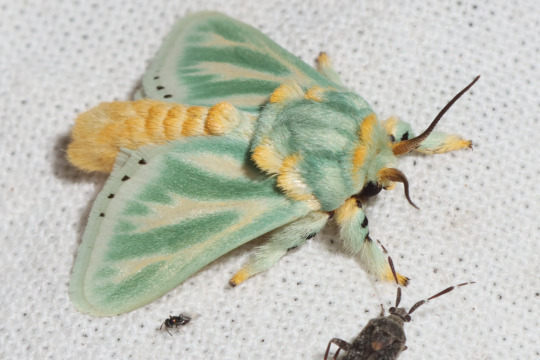


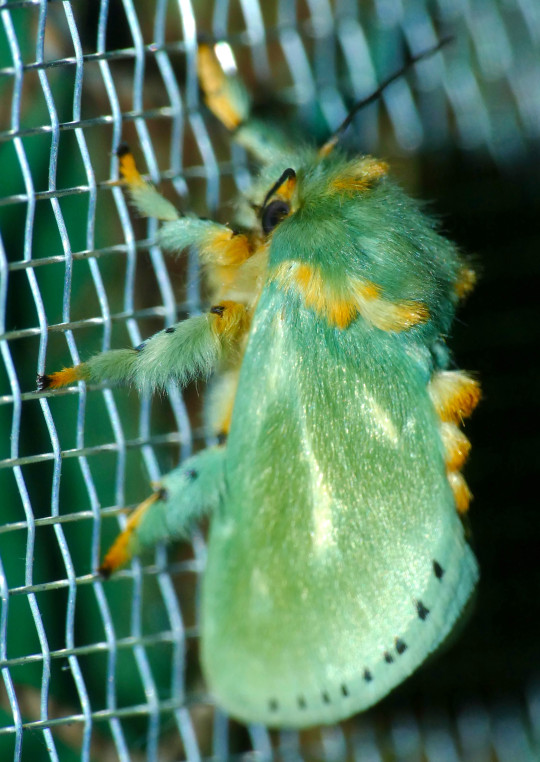
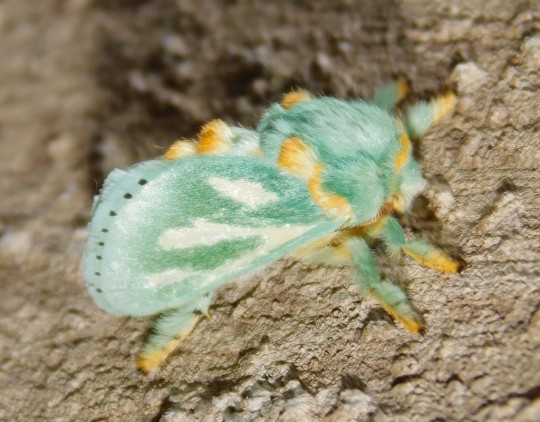
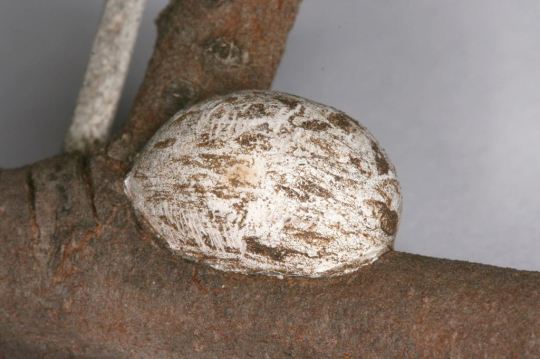
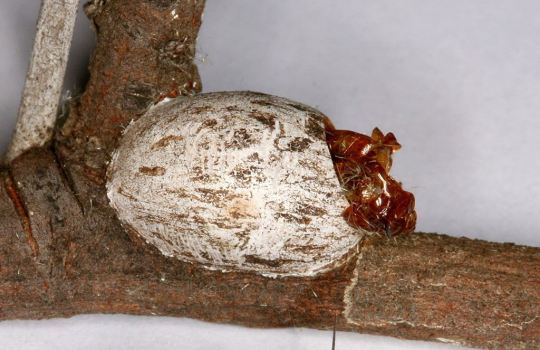
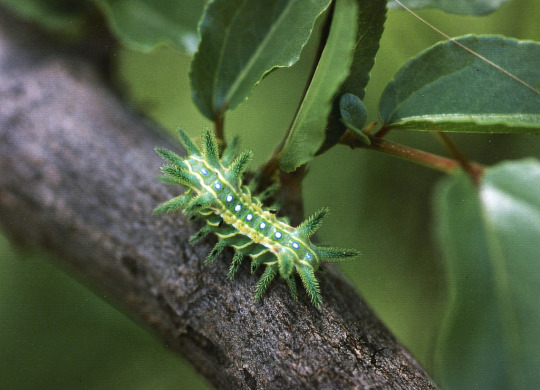
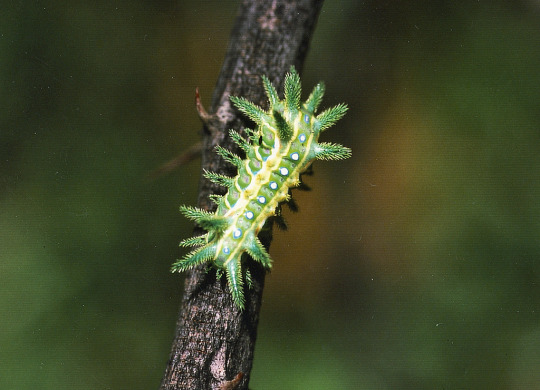

Southern African slug moth, Coenobasis amoena, Limacodidae
Photo 1 by thijsvalkenburg, 2 by nikiescott, 3 by fubr, 4 by Bernard Dupont, 5 by qgrobler, 6-7 (cocoon before and after moth emerged) by nikiescott, 8-9 by wolfachim, and 10 by suncana
#animals#curators on tumblr#insects#bugs#slug caterpillar moth#slug moth#caterpillar#larva#southern african slug moth#cup moth#cocoon#pupa#one nice bug#limacodidae#Coenobasis amoena
15K notes
·
View notes
Text

AJPAINT TAV ^V^
215 notes
·
View notes
Text
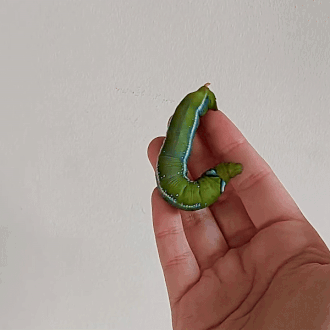


oleander hawkmoth (daphnis nerii) | stonedaffection on ig
#stim#moths#caterpillars#bugs#sfw#green#blue#brown#white#pupae#cocoons#insects#animals#shiny#wings#oleander hawkmoth#daphnis nerii#hands#ishy gifs#postish
238 notes
·
View notes
Text


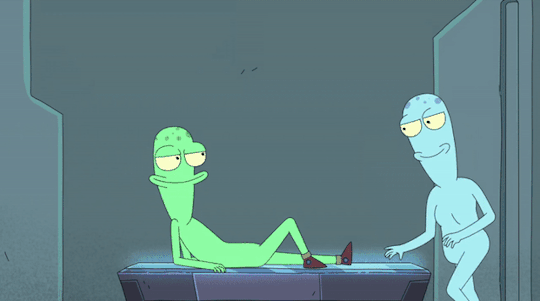

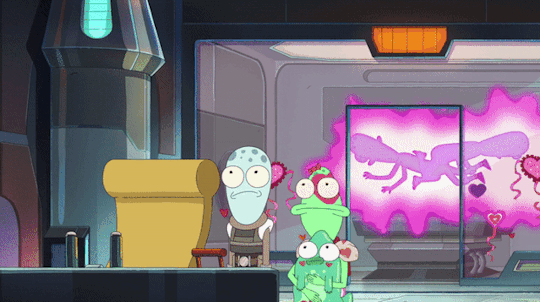



Does that mean we... love each other?
#Solar opposites#terry opposites#korvo opposites#jesse opposites#yumyulack opposites#the pupa#tervo#adult animation#gifs#tvma#this show is the greatest reverse-queer-bait of my life
231 notes
·
View notes
Text
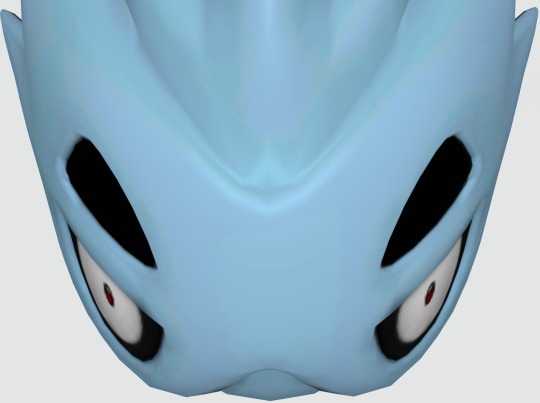

#pupitar#this pokémon has something i'm coming to call Expression Syndrome#where its expression seems to drastically change depending on the angle the photo is taken from#just because it has the audacity to Have Eyebrows#or A Mouth or something#i think entei had this too. this thing obviously does because of the eyebrows#bald#i also think i've talked about the logistics of this thing before#it's a weird pupa thing and i don't really know what animals the larvitar line is supposed to be based off of but they don't seem like bugs#and as far as i'm aware‚ bugs are the only things that pupate#also it's bluuuue and larvitar and tyranitar are not bluuue#womp-womp
52 notes
·
View notes
Text
Wet Beast Wednesday: aquatic insect larvae
This Wet Beast Wednesday is going to be different than usual. Instead of an in-depth overview of a specific species or group of species, I'm going to give a general overview of aquatic insect larvae as a whole and then showcase some groups of insects. I'm going to focus on insects that have an aquatic larval stage and terrestrial adult stage, saving adult aquatic insects for another post.
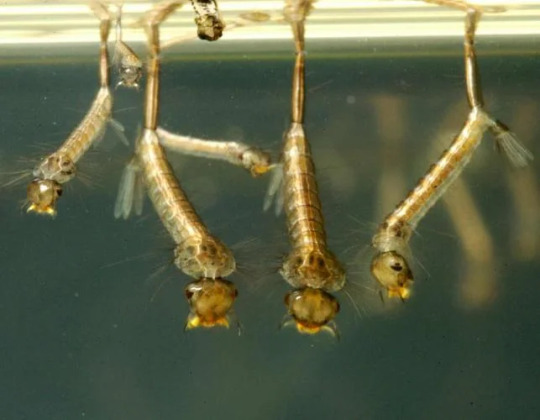
(Image ID: a group of mosquito larvae. They are yellowish bugs with long, slender bodies, no visible limbs, small heads, and feathery appendages from their rear ends. From the back of the abdomen, a snorkel-like appeadage attaches to the surface of the water, using surface tension to allow the larvae to hang from the surface. End ID)
Insects are basically the most successful group of animals in the history of life on Earth and have adapted to live in just about every terrestrial habitat. It should not be much of a surprise than that they have also moved into the water. More specifically, fresh water as almost all aquatic insects inhabit fresh or maybe brackish water. Only the water strider genus Halobates are truly marine. Some species of insect are aquatic for their entire lives, some are primarily terrestrial but able to swim, and some are aquatic only for their larval stage of life. These aquatic larvae species are generally agreed to have evolved from fully terrestrial ancestors. The adaptation of partially returning to the water has evolved independently many times in many different clades of insect and so different species use different strategies and adaptations. It is possible that aquatic larvae evolved in response to high competition for resources on land. If multiple species are competing over the same resources during their larval stages but one of those species manages to adapt to a whole new environment, that species will now have abundant access to resources the other species are unable to get to. Because of the very different lifestyles required for aquatic and terrestrial animals, aquatic larvae often look very different than their adult forms.
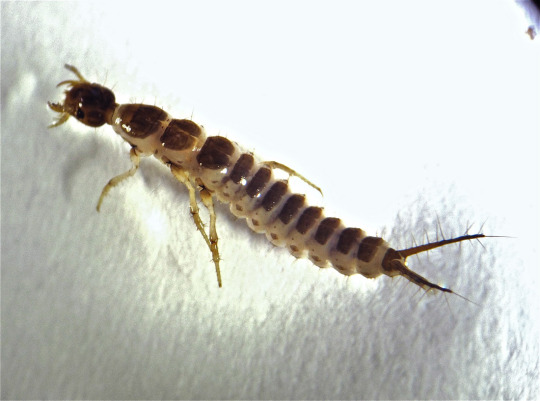
(Image: an aquatic beetle larva. It looks nothing like an adult beetle, instead being a long, slender insect with no wings, multiple body segments, and two hairy appendages at the base of the abdomen. End ID)
Aquatic larvae serve important roles in their ecosystems. Many are herbivores or detritivores that consume algae and bits of biological material, helping recycle nutrients and clean the water. Some are predators that hunt smaller invertebrates or plankton. Importantly, aquatic insect larvae provide a major food source for larger fish, invertebrates, birds, and so on. Some species can be considered keystone species, vital to their ecosystems. Many species are highly sensitive to changes in their environment, allowing them to act as indicator species for the health of their ecosystems. The trio of mayflies, stoneflies, and caddisflies are very commonly used as indicators of pollution as all three are highly sensitive to pollutants. A stream with few mayflies, stoneflies, or caddisflies but plenty of less sensitive species is likely to be polluted.
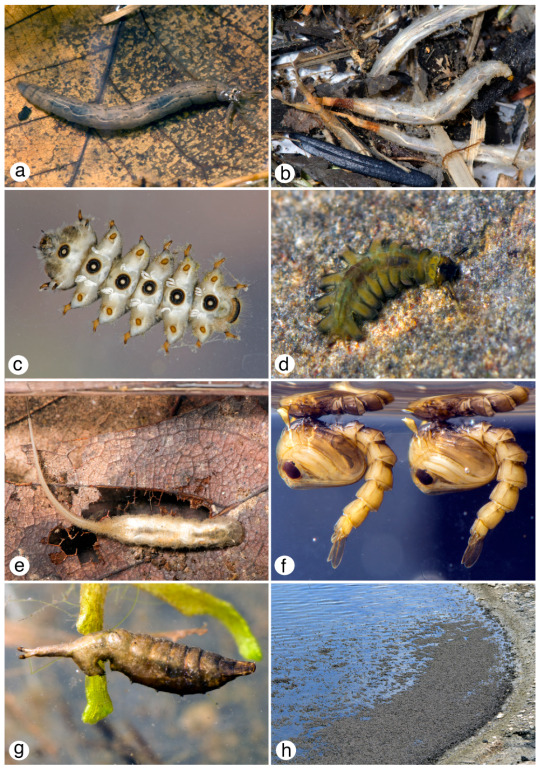
(Image ID: a collage of aquatic larvae of multiple species in the order Diptera (true flies. They vary from slug-like to having multiple distinct body segments with legs, to looking like maggots with long tails. End ID. Source)
Mayflies (order Ephemeroptera) are among the oldest lineages of winged insects, bearing traits that they first flying insect also had. Juvenile mayflies are technically not larvae, but nymphs. The difference between a larva and a nymph is that nymphs look much more like the adult stage than larvae do. Mayfly nymphs lack the wings of adults, but have external gills growing from the sides of their abdomens. Mayfly nymphs can be identified by three appendages called cerci that emerge from the back of the abdomen. They are bottom-dwellers that typically live under rocks and other objects or amid plants. Most are herbivores, feeding mainly on algae. Months to years after hatching (species dependent), mayflies will float to the surface and go through a molt to a stage called the subimago. Uniquely among insects, mayflies go through two final winged molts. The first is to a not sexually mature stage called the subimago, then they quickly molt again into a fully mature imago stage. These molts happen in sync, resulting in hundreds to thousands of mayflies appearing all at once and swarming together to mate. Famously, adult mayflies exist only to mate and die. Their digestive systems are non-functional and few species last past a few days.
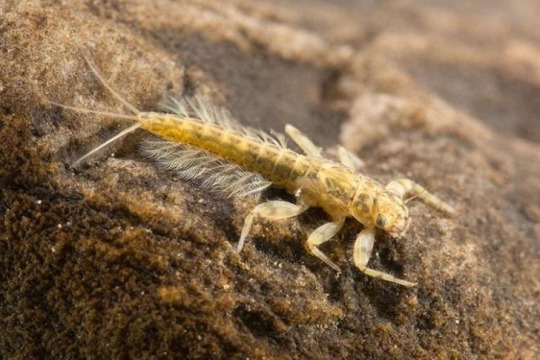
(Image: a mayfly nymph on a rock. It is a yellow bug with no wings, a long abdomen, and thick, grasping legs. Three long, hairy cerci emerge from the back. Along the side of the abdomen are multiple pairs of white, feathery gills. End ID)
Stoneflies (order Plecoptera) also have nymphs and can be quite difficult to tell apart from mayfly nymphs if you don't know what to look for. One of the biggest differences is that their gills are located by the base of the legs rather than along the abdomen. Like mayflies, stoneflies are some of the most primitive winged insects, but mayflies are Paleopterans (the earliest wings insects) while stoneflies and most other winged insects are Neopterans. The main difference is that Neopterans can flex their wings over their abdomens while Paleopterans cannot, and must hold their wings either out to the side or up in the air. Like with Mayflies, many adult stoneflies have nonfunctional digestive systems and exist only to mate and die.
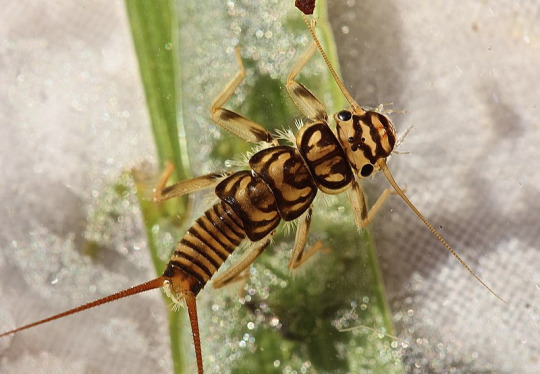
(Image: a stonefly larva. It looks similar to a mayfly larva, but has a shorter abdomen, gills along the base of the legs, and only two cerci. End ID)
Caddisflies (order tricoptera) are the builders of the aquatic insect world. These larvae (most species anyway) can produce silk from glands near their mouths. These are used to make a variety of structures made from silk and various other materials including sand, silt, plant parts, shells, rock, and so on. Different species will seek out specific materials for their structures. There are a few types of structures, the most common of which is a tubular case that is open at both ends. The larva can carry the case with it as it crawls around and can retreat into the case for protection. The larva can draw water into one end of the case and out the other, allowing oxygenated water to flow over the gills. By moving around in the case, the larva can draw in more water. This allows the larvae to survive in water that is too oxygen-poor for other larvae. Other species build different structures including turtle-shell like domes or stationary retreats. My favorite structures are nets built with an open end into current. The current naturally brings detritus and micro-invertebrates into the net, where the larva can eat them. Caddisflies also pupate into pupa that have mandibles to cut their way out of their cases and swimming legs. Once developed, the pupae swim to the surface and molt into their adult forms. This molting is synchronized to ensure the adults emerge in swarms and can easily find mates.
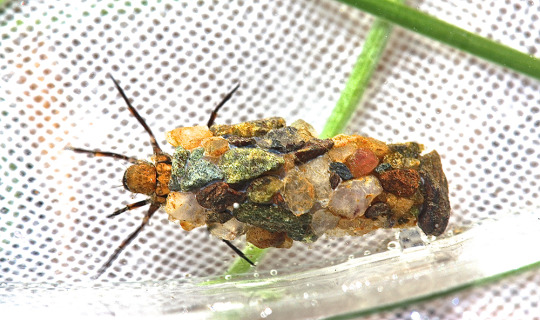
(Image ID: a caddisfly larva in its case. The case is a tube composed of pebbles of different colors stuck together with silk. The head and legs of the larva are merging from the front of the case. End ID)
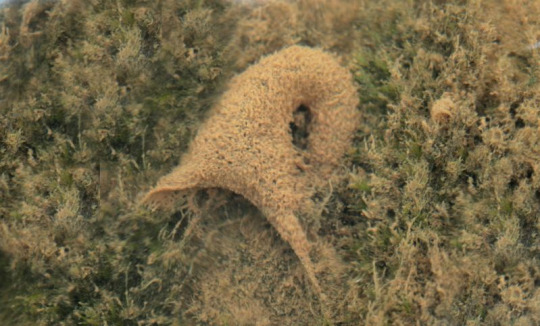
(Image: a caddisfly net. It is a structure made of silk shaped like a tube that is wide at one end and tapers toward the other. It is curved so both ends face the same way. End ID)
The order Megaloptera consists of alderflies, dobsonflies, and fishflies. All three have aquatic larvae, but their eggs are laid on land. Most species lad their eggs on plants overhanging the water so the larvae fall in once hatched, though a few lay eggs near the water's edge, forcing the larvae to crawl in. Meglaoptera have the least amount of differences between larva and adult of all holometabolous (pupa-forming) insects. The largest differences between the larvae and adults is the larvae lack wings and some species have leg-like prolegs. All species are carnivorous as larvae and feed on other invertebrates.
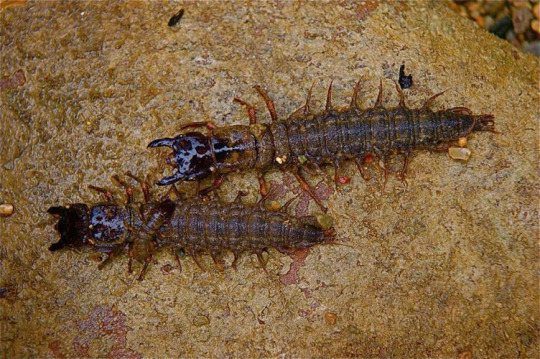
The adults don't look any less creepy
(Image: two hellgrammites, the larval form of a dobsonfly. It looks somewhat like a centipede with three pairs of limbs and a long abdomen with multiple pairs of leg-like prolegs. The head has no visible antennae, but does have a pair of powerful pincers. End ID)
Order Odonata consists of dragonflies and damselflies. These are powerful predators both as nymphs and adults. As nymphs, the juveniles are shorter and stockier than the adults, with no wings. The nymphs (or naiads) breathe through gills. In damselflies, these gills can be external, but dragonfly nymphs have their gills located in the anus. Damselflies can swim by undulating their gills, but dragonfly nymphs are restricted to crawling. The nymphs are voracious predators that will feed on anything they can catch. Most of their diet consists of invertebrates, but they will also attack small fish, tadpoles, and even salamanders.
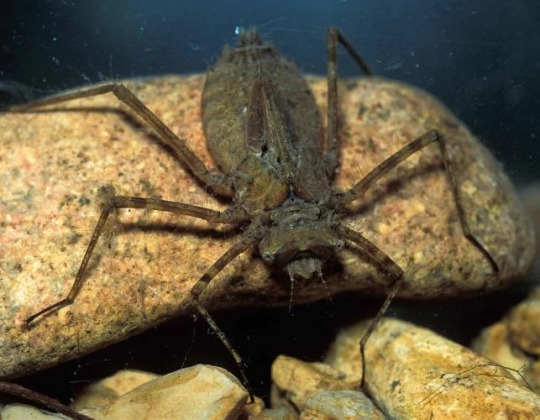
(Image ID: a dragonfly larva on a rock. Its head is similar to that of the adults, but the abdomen is much shorter and broader and the legs are longer. It has no wings and is brown all over. End ID)
The groups of insects I covered today (plus the stoneflies) all have exclusively or near-exclusively have aquatic larvae while the adults are terrestrial. In other groups, aquatic larvae may be present in some species while others have terrestrial larvae. For example, a great many members of the order Diptera (true flies) have aquatic larvae including all mosquitos, while other members of the order have fully terrestrial larvae. In addition there are species of beetle (order Coleoptera), moth (order Lepidoptera), lacewing (order Neuroptera), and scorpionflies (order Mecoptera) that have aquatic larvae and some species of the true bugs (order Hemiptera) have aquatic larvae and aquatic adults, including water skaters, water scorpions, and giant water bugs. Aquatic insects are so prevalent that it is rare to find any lasting body of water that doesn't host some aquatic larvae or adults. Even incredibly stagnant and filthy water can host aquatic insect larvae, as shown by the notorious rat-tailed maggots, who love stagnant water and breathe through snorkels. Many species require very specific conditions and there are species of insect who exclusively grow their larvae in specific streams or lakes. Because of this, conservation of these bodies of water is vital to their survival and pollution, damming, and other factors can destroy whole species.
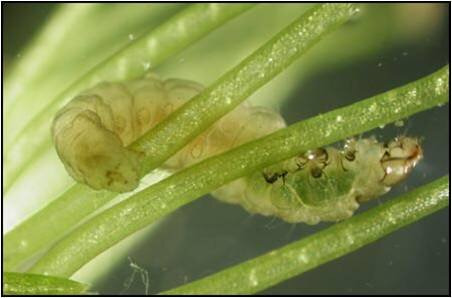
(Image: an aquatic moth larva. It looks very similar to a green land caterpillar, with none of the fancy elements many land species have. It is translucent and wrapped around some aquatic plant stems. End ID)
#wet beast wednesday#insects#insect larvae#aquatic insect larvae#larva#pupa#mayfly#stonefly#caddisfly#dobsonfly#hellgrammite#dragonfly#damselfly#freshwater ecology#ecology#biology#zoology#invertebrate#invertebrates#animal facts#informative#bug#bugs
81 notes
·
View notes
Text

Family Hug! 😂💕
X account: @w_wildgirl
https://www.instagram.com/wild_girl_nest
#fan art#digital art#digital anime drawing#digital illustration#procreate#ink#inkdrawing#solar opposites human#solar opposites yumyulack#solar opposites tervo#solar opposites korvo#solar opposites hulu#solar opposites jesse#solar opposites terry#solar opposites#terry opposites#terry x korvo#tervo fanart#tervo#korvo opposites#korvo#yumyulack opposites#jesse opposites#the pupa#family hug
24 notes
·
View notes
Text

my friends and me every time there's drama in the group chat
#hulu#television#adult animation#comedy#valentine's day#tervo#solar opposites#yumyulack#korvo#terry#pupa#jesse#sean giambrone#mary mack#dan stevens#thomas middleditch
110 notes
·
View notes
Text

The weirdest trip I have ever been on and I enjoyed it, despite that I wouldn’t recommend it, unless you enjoy this kind of weirdness.  The plot is all over the place, you would be so confused in the end of it all. Nonetheless it most watch just to see at least once no matter how bad it is.  for those who are into weird  enjoy the ride.
1 note
·
View note
Text
I just started Pupa and this is really good but supremely disgusting
Dark red btw
1 note
·
View note
Photo









Bagworm moth (Psychidae) larval and pupal cases
Photographed in Southeast Asia by Nicky Bay // Website // Facebook
Shared with permission; do not remove credit or re-post!
#animals#curators on tumblr#insects#bugs#moth#bagworm moth#caterpillar#larva#pupa#bagworm#camouflage#psychidae#one nice bug
2K notes
·
View notes
Text




Ant pupae in a nest I had to disturb last year during trail cleanup. Lucky for them, the adults were hard at work relocating them to safety.
Complex Formica fusca, Northeastern Pennsylvania, US
#ants#formica#formica fusca#nature#bugs#nature photography#biodiversity#animals#bugblr#inaturalist#arthropods#entomology#insect appreciation#macro#macro photography#Formicidae#hymenoptera#pupa#pupae#babies#children#parenting#biology#invertebrates#ant nest
28 notes
·
View notes
Text
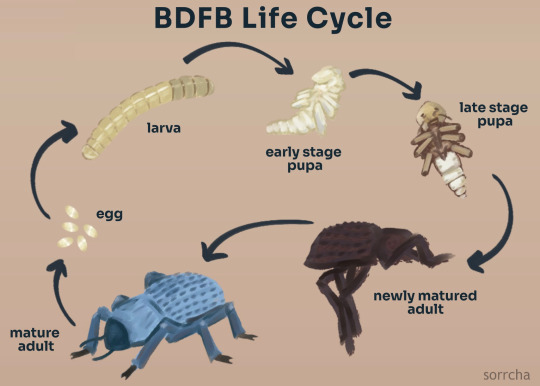
made a quick visual of the BDFB life cycle for my experimental design class project. figured it looked nice enough to share here ^^
there's only four stages (egg -> larva -> pupa -> adult), but i decided to make the graphic with more detail bc it's relevant to my project :-)
#art#digital art#animal#insect#beetle#darkling beetle#blue death feigning beetle#life cycle#life cycle diagram#diagram#bugblr#insectblr#the diagram is simpler than i wanted but it's great considering how much i procrastinated on making it (ovo)''#the project was to design a fake experiment as a mock GRFP. i went with BDFBs and the substrate they pupate best in as my topic!#larva#pupa#<- tagging bc ik some ppl find those a lil creepy#hall of fame
285 notes
·
View notes
Text
Little Bobble 🦋

(this took all day and was just me testing out my animation program OTL my brain is fried!!)
#Pupa Project#Blythe Waldrop#oc art#oc artist#oc artwork#animation#oc animation#toonsquid#horror oc#yamikawaii#creepy cute#artists on tumblr#character animation#original character
9 notes
·
View notes